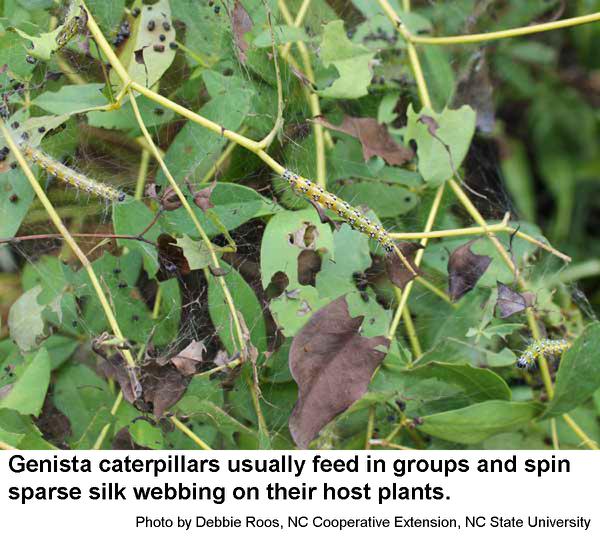Description and Biology
The genista broom moth, Uresiphita reversalis, is also called the genista caterpillar and sophora worm. The moths are light to medium brown with a dark spot on each top wing. The hindwings are yellow or orange with some brownish-gray shading toward the edges. Females lay eggs in batches of up to about 70. The tiny, newly hatched caterpillars are green and blend in on the foliage. Larger caterpillars are brownish-green with raised black spots and bright yellow patches on each segment. Each black spot has a white dot at tip that sports sparse, long white hairs. The head is black with white dots as well. It overwinters in cocoons on or near the base of its host plants and the moths emerge the following year to mate and lay eggs from which hatch the tiny, hairy caterpillars that soon grown into larger hairy caterpillars. They can become abundant enough to cause extensive defoliation. Genista broom moths have four to five generations per year in North Carolina and the caterpillars are usually most abundant in late summer or early fall.
Host Plants
Genista caterpillars feed on acacia, brooms (Genista spp.), Scotch broom, Texas mountain laurel (Sophora secundiflora), blue wild indigo or false indigo (Baptisia australis), and lupine. It has also been reported from crapemyrtle and honeysuckle as well as "other pea family shrubs." Genista caterpillars ingest and store alkaloids from their host plants, which make the worms bitter or even toxic to mammals and birds and some insect predators (so don't eat them!).
Residential Recommendations
Genista caterpillars are probably not resistant to insecticides. However, when the worms are fully grown, they may be somewhat resistant to pesticides because they are no longer feeding and are getting ready to spin their cocoons. Younger caterpillars are generally more susceptible to pesticides including insecticidal soaps, horticultural oils, Bacillus thuringiensis insecticides, and neem seed extract insecticides. For larger caterpillars, it might be better to use a pyrethroid insecticide such as permethrin, bifenthrin, and lambda cyhalothrin because pyrethroids are generally very toxic to caterpillars and they have long-lasting residues. It would be well to watch for these caterpillars next year as some of them may survive the winter away from the area being sprayed. The cocoons will at least partially protect the caterpillars or pupae inside. These insecticides are available in the garden sections of big box stores, nurseries, and other plant centers
References
- Aposematism of Uresiphita reversalis Larvae (Pyralidae). Bernays, E. A. and C. B. Montllor. 1989. Journal of the Lepidopterists' Society 43 (4): 261-273.
- Genista Caterpillar on Baptisia. Roos, D. 2012. Growing Small Farms, NC State Extension.
- Genista Caterpillar on Texas Mountain Laurel. Drees, B. M. and C. Bogran. 2017. Landscape IPM, Texas A&M AgriLife Extension.
- Species Uresiphita reversalis - Genista Broom Moth - Hodges #4992. Roberts, J. D. 2007. BugGuide. Identification, Images, & Information For Insects, Spiders & Their Kin For the United States & Canada.
- NC State Extension Plant Pathology Publications
- NC State Horticultural Science Publications
- North Carolina Agricultural Chemicals Manual
For assistance with a specific problem, contact your local Cooperative Extension center.
This factsheet has not been peer reviewed.
Publication date: Aug. 25, 2017
Revised: June 3, 2022
Recommendations for the use of agricultural chemicals are included in this publication as a convenience to the reader. The use of brand names and any mention or listing of commercial products or services in this publication does not imply endorsement by NC State University or N.C. A&T State University nor discrimination against similar products or services not mentioned. Individuals who use agricultural chemicals are responsible for ensuring that the intended use complies with current regulations and conforms to the product label. Be sure to obtain current information about usage regulations and examine a current product label before applying any chemical. For assistance, contact your local N.C. Cooperative Extension county center.
N.C. Cooperative Extension prohibits discrimination and harassment regardless of age, color, disability, family and marital status, gender identity, national origin, political beliefs, race, religion, sex (including pregnancy), sexual orientation and veteran status.




